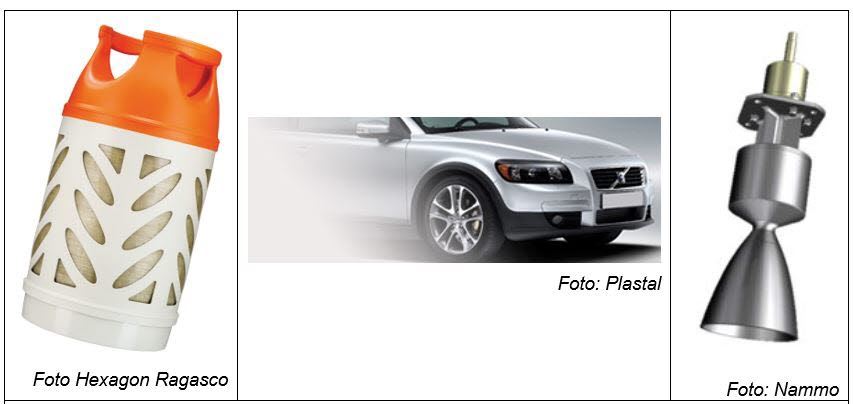The industrial partners in the project develop and produces products for different markets; gas containers for household applications and automotive industry, rocket engines for missile and spacecraft applications and exterior components for cars.
Gas container in thermoplastics/composite
The containers consist innermost of a blow moulded liner which is surface treated before a primer layer (lacquer) is added. Finally, a glass fibre reinforced resin is wound on the outside, which is subsequently cured. The outer shell gives pressure resistance, while the permeability depends on the properties of the liner material, lacquer and the adhesion between the different layers.
Injection moulded and lacquered plastic components for automobiles
By developing methodologies and manufacturing processes that ensure good adhesion of lacquer on injection moulded plastic components, we will improve product quality and production efficiency. One of the goals is to the improve flame treatment process before lacquering.
Increased life for rocked engines
Both longer life and new applications for rocket engines can be achieved by protecting the fuel from moisture. This can be achieved by controlling and improving solutions related to the diffusion of moisture through both the main structure and sealants. This has application in rocket motors for missiles and aeronautics.
Overall project goals
The overall objective of the project is to develop new products with enhanced adhesion between layers of different polymeric materials and improved barrier properties, ie with reduced permeability of various gases through the structure.
Challenges and methodology
We will realize the project goals through increased understanding of the mechanisms that affect both adhesion and barrier properties related to material properties, surface chemistry and fracture mechanisms. Sensitive measurement techniques will be developed for testing permeability of gases, such as propane, butane, natural gas and moisture through different materials and with different geometries. Permeability of hydrocarbons and water vapour requires the development of different experimental methods. Through analysis based on fracture mechanics in order to understand the mechanisms of adhesion between different polymer layers we, will develop more relevant test conditions, thereby increasing the understanding of surface modification and lacquering processes.
The project is partially financed by the Norwegian Research Council through the BIA IPN program. The consortium consist of the industrial partners Hexagon Ragasco AS (project owner and responsible company), Hexagon Raufoss AS, Plastal AS and Nammo AS and with SINTEF Material and Chemistry (project leader Åge Gellein Larsen ) and SINTEF Raufoss Manufacturing (Contakt person Jon Sandvik )as research partner.
